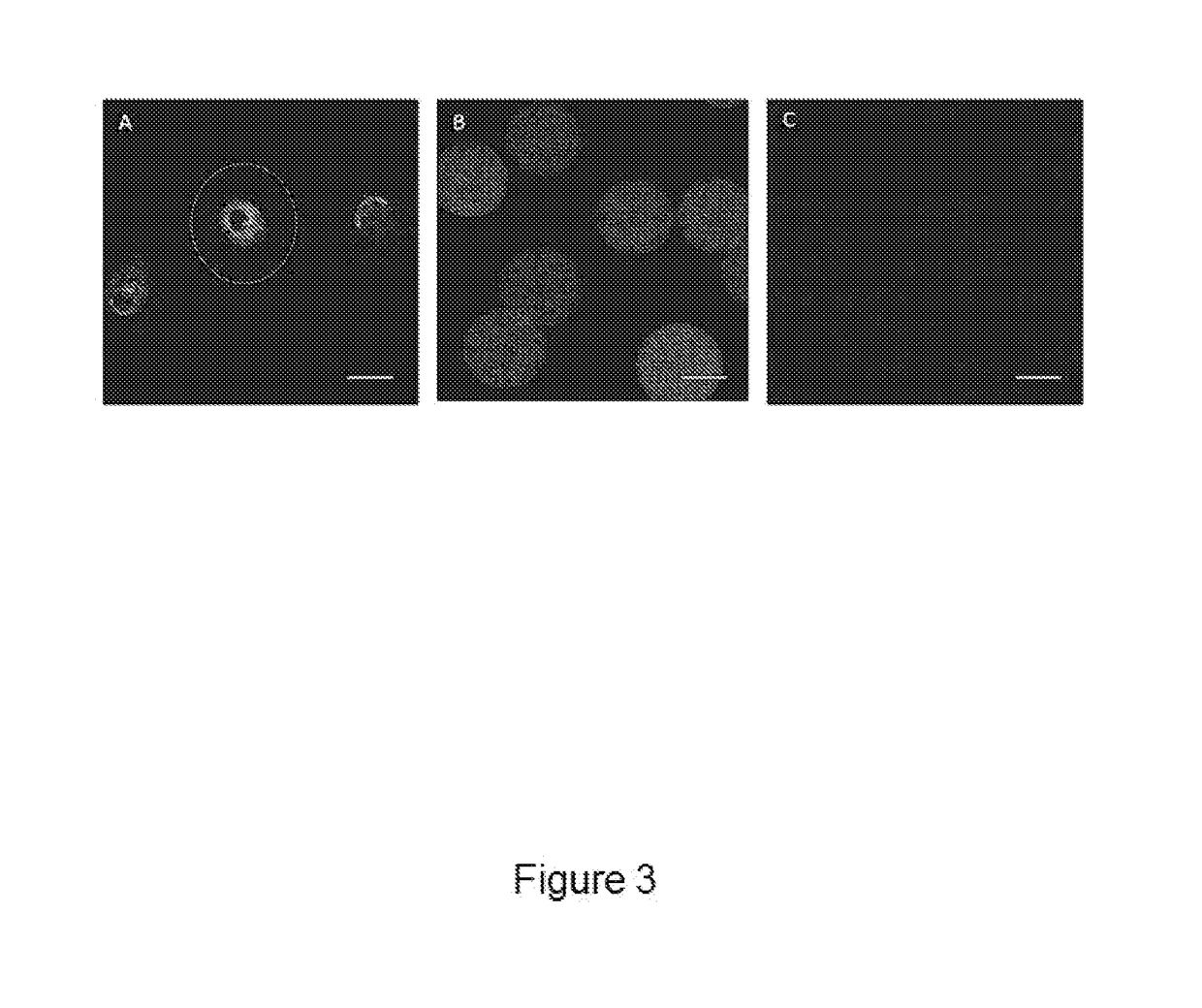Natural Polymer-Derived Scaffold Material and Methods for Production Thereof
a scaffold material and natural polymer technology, applied in the field of tissue engineering, can solve the problems of difficult control of physical parameters such as degradation rate, affecting the release kinetics of growth factors, and inability to show beneficial effects for patients in trials, etc., and achieve the effect of increasing the polymer density and altering the in vitro degradation ra
- Summary
- Abstract
- Description
- Claims
- Application Information
AI Technical Summary
Benefits of technology
Problems solved by technology
Method used
Image
Examples
example 1
on of Fibrin Beads
[0154]Fibrin beads were obtained by modifying a flow-focusing microfluidic system previously described in an article by Allazetta et al. (Allazetta S 2013), the content of which is incorporated herein by reference in its entirety. Computer-controlled syringe pumps (neMESYS from Cetoni, Germany) were used to adjust flow rates. Briefly, one microfluidic channel was loaded with 40 mg / mL of human fibrinogen (plasminogen, fibronectin-depleted; Enzyme Research Laboratories, South Bend, Ind., USA) at a flow rate of 1.5 μl / min and the second channel was loaded with an enzyme solution containing 200 U / mL human thrombin (Sigma Aldrich, Switzerland), 200 U / mL factor XIIIa (Fibrogammin, CSL Behring UK) and 10 mM Ca2+ in tris-buffered saline (TBS) at a flow rate of 1 μl / min. For the fabrication of bioactive fibrin beads, the enzyme solution was supplemented with a recombinant IGF-1 (α2PI1-8-MMP-IGF-1). The fibrinogen and enzyme solution were injected into an oil phase of 2% (w / ...
example 2
ical Characterization of Fibrin Beads
[0155]The surface morphology of fibrin beads was studied using Scanning Electron Microscopy (SEM) (FIG. 2A) as described below. The obtained fibrin beads were very homogeneous in terms of size and porosity, showing highly dense fiber bundling (FIG. 2B). The average diameter of the fibrin beads was around 140 μm as determined by bright-field microscopy and image analysis using the software ImageJ (FIG. 2C). Fibrin beads were analyzed for their functional groups via FT-IR analysis. The FT-IR spectrum of fibrinogen demonstrated its characteristic amide absorption bands at around 1643 cm-1, 1550 cm-1, and 1240 cm-1, which are indicative of amide I, II, and III groups, respectively (FIG. 2D). The same bands for fibrin were observed around 1687 cm-1, 1550 cm-1, and 1276 cm-1. The bands at around 1110 cm-1 can be attributed to C—N stretching (FIG. 2D). The absence of characteristic silicone bands around 800 cm-1, 1022 cm-1, and 1100 cm-1 showed the obta...
example 4
n of Fibrin Bead Degradation In Vitro
[0162]Fibrin beads were added to hSMCs seeded 12 well-plates and cultured for 7 days to determine their degradation behaviour in the presence of cells as described below. At different time points fibrin beads were visualized under a bright-file microscope and the number and the diameter of non-degraded beads was determined (FIGS. 5A and 5B). In vitro degradation results demonstrated that 93% of fibrin beads were degraded after 4 days of incubation with hSMCs (FIG. 5A). However, fibrin gels, having the same protein concentration as the fibrin bead samples, showed a considerably higher mass loss after 24 hours. Fibrin gels lost around 87% of their initial mass within the first day when incubated with cells (data not shown). In contrast, the average diameter of non-degraded fibrin beads did not change significantly at any time point (FIG. 5B).
[0163]Cell Culture
[0164]Human smooth muscle cells (hSMCs) were extracted from human ureter biopsies, and cul...
PUM
| Property | Measurement | Unit |
|---|---|---|
| Fraction | aaaaa | aaaaa |
| Fraction | aaaaa | aaaaa |
| Fraction | aaaaa | aaaaa |
Abstract
Description
Claims
Application Information
 Login to View More
Login to View More - R&D
- Intellectual Property
- Life Sciences
- Materials
- Tech Scout
- Unparalleled Data Quality
- Higher Quality Content
- 60% Fewer Hallucinations
Browse by: Latest US Patents, China's latest patents, Technical Efficacy Thesaurus, Application Domain, Technology Topic, Popular Technical Reports.
© 2025 PatSnap. All rights reserved.Legal|Privacy policy|Modern Slavery Act Transparency Statement|Sitemap|About US| Contact US: help@patsnap.com



